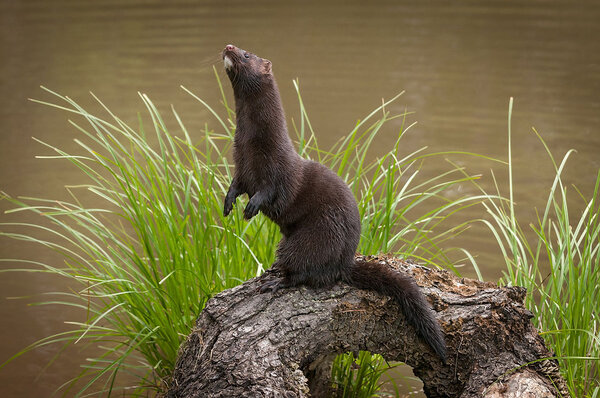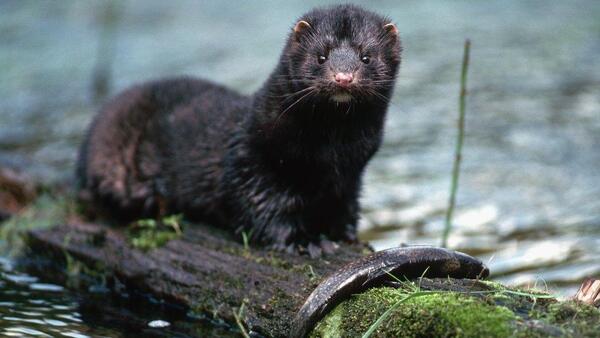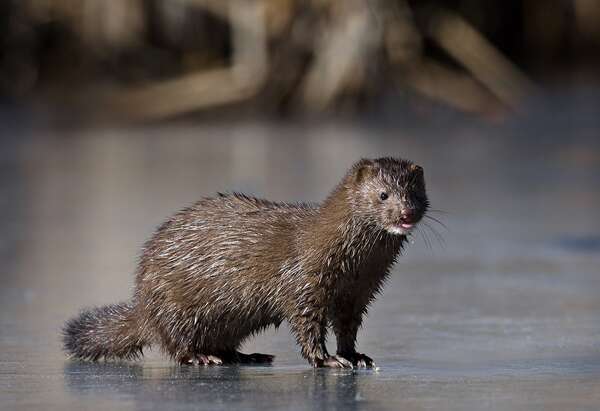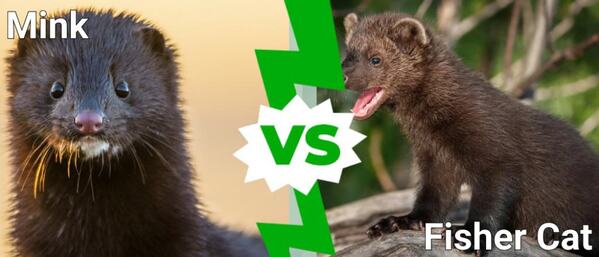Minks are small, semi-aquatic mammals that belong to the weasel family, Mustelidae. There are two main species: the American mink (Neovison vison) and the European mink (Mustela lutreola). These animals are known for their luxurious fur, which has historically made them a target for the fur industry. While American minks are widely distributed across North America and have been introduced to other regions, European minks are native to Europe and are now endangered. Both species are found near bodies of water, where they hunt and thrive in wetland habitats.

Minks are sleek, agile animals with long, slender bodies, short legs, and a bushy tail. Here’s a quick overview of their physical traits:
Size: Minks typically measure about 12 to 18 inches (30 to 45 cm) in body length, with an additional 5 to 9 inches (13 to 23 cm) in tail length.
Weight: They weigh between 1.5 to 4 pounds (0.7 to 1.8 kg), with males being larger than females.
Color: Minks have dense, waterproof fur that is usually dark brown, sometimes appearing almost black. American minks can have white patches on their throat and chest, while European minks usually have distinct white markings on their upper lips.
Adaptations: They have webbed feet and thick fur, both of which help them in aquatic environments. Their sharp teeth and claws make them effective predators.
Minks are primarily found in wetland habitats, including rivers, lakes, marshes, and coastal areas. They prefer areas with plenty of cover, like dense vegetation, rocks, and fallen logs.
American Mink: Widely distributed across North America, from Canada to the southern United States. American minks have also been introduced to Europe and parts of Asia, where they have established populations.
European Mink: Native to Eastern and Central Europe, this species has seen a significant decline in its natural range due to habitat loss, competition from the invasive American mink, and hunting. It is now classified as endangered.
Minks are carnivorous and skilled hunters, preying on a variety of animals. They are solitary and highly territorial, marking their territories with scent glands.
Diet: Their diet mainly consists of fish, amphibians, small mammals, birds, and invertebrates. Minks are known to be opportunistic feeders, and their diet varies depending on the available prey in their environment.
Hunting Skills: Minks are adept swimmers, capable of diving up to 16 feet (5 meters) underwater. Their sharp claws and teeth allow them to catch slippery prey, such as fish and frogs.
Behavior: Primarily nocturnal, minks are most active at dawn and dusk. They are solitary creatures, only coming together for mating. Each mink has a home range it defends, though male and female territories may overlap.
Minks have a unique reproductive cycle, with mating typically occurring between February and April. Here are key points about their life cycle:
Breeding: Mating is brief and often aggressive, with males sometimes pursuing multiple females.
Gestation: Mink gestation is about 40 to 75 days due to a phenomenon known as delayed implantation, where the fertilized egg doesn’t immediately attach to the uterus, allowing for flexibility in timing the birth.
Litter Size: A female mink usually gives birth to a litter of 4 to 6 kits, though litter size can range up to 10.
Development: Kits are born blind and helpless, relying on their mother for warmth and nourishment. They are weaned at about six to eight weeks and reach full independence by around 10 to 12 weeks.
Minks play an essential role in controlling small animal populations in their ecosystems. However, the introduction of the American mink to non-native areas has caused ecological disruption.
Predation: In Europe, the American mink competes with native species, including the European mink and some bird species, which can lead to declines in local biodiversity.
Invasive Species: In places where they are not native, such as parts of Europe, American minks are considered an invasive species, often outcompeting local animals for resources.
While American minks are abundant and have stable populations, European minks are endangered due to habitat loss, competition with American minks, and human activities. Conservation efforts are focused on protecting their habitats and controlling American mink populations in Europe to aid in the recovery of the European mink.
Conservation Efforts: European conservation programs aim to protect and restore mink habitats, control invasive American mink populations, and sometimes breed European minks in captivity for reintroduction into the wild.
Endangered Status: The European mink is classified as endangered by the International Union for Conservation of Nature (IUCN), while the American mink is of least concern due to its widespread and stable population.
Historically, minks have been highly valued for their fur, leading to the establishment of mink farms worldwide. However, concerns over animal welfare have prompted debates and led to increased regulation of the fur industry in many countries.
Fur Farming: Mink fur has been used in the fashion industry for centuries. However, concerns over the ethics of fur farming, including animal treatment and environmental impact, have led some countries to ban or restrict fur farming.
Shifting Public Perception: With growing awareness of animal welfare, many fashion brands and consumers are moving away from fur, opting for cruelty-free alternatives instead.
Minks are fascinating animals that thrive in aquatic environments, with impressive hunting skills and a complex role in their ecosystems. While they are not inherently dangerous to humans, they can act defensively when threatened. American minks are widespread, but European minks are endangered and need conservation efforts to help protect and restore their populations.
Whether in the wild or within human-controlled environments, minks continue to intrigue people with their agility, adaptability, and beautiful, yet controversial, fur.
In general, minks are not considered a direct threat to humans. However, they are known for being bold, agile, and territorial animals. While they tend to avoid human contact, they will defend themselves if they feel threatened. Here are some important points about mink behavior:
Territorial Nature: Minks are solitary animals with strong territorial instincts, especially males. They mark and protect their territories, which can make them aggressive towards other animals or minks intruding on their space.
Predatory Skills: As carnivores, minks are agile hunters with sharp teeth and claws. They primarily prey on small animals such as fish, birds, rodents, and frogs, and can be aggressive in their pursuit of food.
Defensive Behavior: When cornered or feeling threatened, minks will defend themselves. Their sharp teeth and strong bite can cause injury if they feel the need to protect themselves.

Minks, particularly in the wild, are known for their aggressive behavior. As members of the Mustelidae family, which also includes animals like weasels, otters, and wolverines, minks have a reputation for being fierce and territorial, especially when they feel threatened or are defending their territory. Here’s a breakdown of why minks can be aggressive and what situations tend to trigger this behavior:
Minks are carnivorous animals with strong hunting instincts. They primarily prey on fish, small mammals, birds, and amphibians. To catch and subdue their prey, minks rely on agility, sharp teeth, and claws. This hunting behavior means they are naturally aggressive toward animals smaller than themselves.
Their high metabolism requires them to hunt frequently, which further encourages this aggressive and predatory nature.
Minks are solitary and highly territorial animals. They mark their territory with scent to warn other minks to stay away, and they will defend it aggressively against intruders, even if the intruder is another mink.
If another animal encroaches on their territory, minks are known to become confrontational and may engage in physical altercations to protect their space.
Minks may show aggression if they feel threatened or cornered. In such situations, they may bare their teeth, hiss, or even attack to protect themselves. This defensive aggression is more likely in wild minks but can also appear in domesticated or captive minks if they feel scared or stressed.
When domesticated minks are raised on fur farms, they can become accustomed to human contact, though some can still exhibit aggressive tendencies, particularly if they are not handled regularly.
Domesticated minks, often bred in fur farms, may be less aggressive than wild minks, but they retain their natural instincts and can still be unpredictable.
In the wild, minks typically avoid human interaction, but if they are approached or feel cornered, they may react aggressively as a form of self-defense. Wild minks can carry diseases like rabies, which can increase aggressive behaviors and make interactions with them potentially dangerous.
Minks usually try to avoid human contact but may enter urban or suburban areas in search of food, particularly near bodies of water. This can occasionally lead to aggressive encounters if a mink feels threatened.
When it comes to pets, minks can pose a threat to smaller animals like chickens, rabbits, and even some cats. Their agility and aggression make them capable of causing harm to small domestic animals.
While minks are not typically aggressive toward humans unless provoked or cornered, they are capable of biting and scratching if they feel threatened. For small animals, minks can indeed be dangerous predators. Their aggressive behavior is mostly a result of their predatory instincts, territorial nature, and need for self-defense.
In general, it’s best to avoid handling wild minks and to keep small pets protected if minks are known to inhabit the area. Observing them from a distance is safest and respects their natural behavior.
Though it’s rare, minks can pose a small risk to humans in certain situations, especially when they are sick or feel their territory is at risk. Here are a few scenarios where mink encounters could turn dangerous:
Rabies Transmission: Like other wild mammals, minks can carry rabies, a viral disease that can be transmitted to humans through bites or scratches. Rabid minks may show unusual aggression, making them more dangerous.
Farm and Pet Predators: Minks are known to raid farms, poultry coops, and even domestic spaces for small pets like rabbits or birds. If you live near mink habitats, you may need to take measures to protect small animals from mink attacks.
While minks are not usually a threat, it’s essential to understand how to stay safe, especially if you live in an area with a high mink population:
Keep Your Distance: Avoid approaching wild minks, as they may feel threatened and react defensively.
Protect Small Pets and Livestock: Secure poultry, rabbits, and other small animals, especially if you live near water bodies where minks are common.
Do Not Corner Them: If you encounter a mink, do not try to corner or handle it, as it may respond with aggression.
Be Aware of Rabies Risks: If bitten or scratched by a mink, seek medical help to check for potential rabies exposure. Wild animals that act overly aggressive or unusually tame may carry the virus.
Minks are primarily dangerous to smaller animals due to their predatory habits. They are known for their ability to hunt and are efficient swimmers, making them highly effective hunters in their aquatic environments. Minks are known to prey on:
Fish: Minks are skilled at hunting fish in rivers and lakes.
Small Mammals: They commonly hunt rabbits, rodents, and sometimes even small reptiles.
Birds: Ground-nesting birds and their eggs are at risk, especially near water sources.
In ecosystems where minks have been introduced as non-native species, they have been known to impact native bird and fish populations significantly.
| Criteria | Are Minks Dangerous? |
|---|---|
| To Humans | Rarely, but can bite when cornered. Potential risk if rabid. |
| To Pets and Livestock | Yes, especially to small animals like poultry or rabbits. |
| To Other Wildlife | Yes, as they are skilled predators of fish, birds, and small mammals. |
Both American and European minks have an essential role in their respective ecosystems, as they help control populations of smaller animals. However, the European mink is considered endangered, largely due to habitat loss, competition with American minks, and human impact on their environment. Conservation efforts are in place to protect European minks and restore their habitats.
In summary, minks are not inherently dangerous to humans, but like any wild animal, they can act defensively if threatened. Minks’ predatory instincts make them a potential risk to small pets and livestock, so it’s essential to take protective measures if you live in a mink-populated area. While generally elusive and preferring to avoid human contact, minks are fascinating creatures that play a vital role in their ecosystems.

Minks are part of the Mustelidae family, which also includes animals like otters, weasels, and ferrets. There are two main types of minks: the American mink (Neovison vison) and the European mink (Mustela lutreola). These two species differ significantly in terms of habitat, physical characteristics, conservation status, and interactions with humans.
Here's a detailed table summarizing the key differences between American and European minks:
| Characteristic | American Mink (Neovison vison) | European Mink (Mustela lutreola) |
|---|---|---|
| Native Range | North America | Eastern and Central Europe |
| Introduced Regions | Europe, Asia (as an invasive species) | None |
| Size | Larger: 30-45 cm (body length), 13-23 cm (tail) | Smaller: 28-38 cm (body length), 12-20 cm (tail) |
| Weight | 0.7-2 kg | 0.5-1 kg |
| Color | Dark brown to black, often with white patches on throat and chest | Brown with white markings around the upper lip and chin |
| Habitat Preference | Near water, forests, wetlands | Rivers, streams, and wetlands in forested areas |
| Diet | Opportunistic: fish, crustaceans, small mammals, birds | Mainly amphibians, fish, and small mammals |
| Lifespan | Up to 10 years in the wild | Around 5-6 years in the wild |
| Conservation Status | Least Concern (IUCN) | Critically Endangered (IUCN) |
| Population Trend | Stable; invasive in some regions | Declining significantly due to habitat loss, competition, and hunting |
| Human Interaction | Commonly farmed for fur; invasive impact on local wildlife | Not farmed; impacted by habitat destruction and competition with American mink |
American Mink: Known for its adaptability, the American mink is found not only in North America but also in parts of Europe and Asia, where it has become an invasive species. Its robust population and adaptability have made it a concern in non-native regions, where it competes with and often outcompetes local species, including the European mink.
European Mink: This species is critically endangered, with a declining population across Europe. European minks face threats from habitat destruction, pollution, and competition with the American mink. Conservation efforts are in place, focusing on habitat preservation and controlling the spread of American mink populations in Europe.
Each mink species plays a unique role in its respective ecosystem. However, due to human activities and the introduction of invasive species, the European mink's survival is increasingly at risk.
In the wild, minks are agile and skilled hunters, but they also face several natural predators. The specific threats to minks can vary based on their habitat (North America or Europe), but common predators include:
Large Birds of Prey:
Eagles, hawks, and owls, especially in North America, are natural threats to minks. These birds are skilled hunters with the ability to swoop down and catch small mammals, including minks.
Coyotes and Foxes:
Coyotes, foxes, and other larger mammals are significant predators, particularly in areas where their territories overlap. Foxes are known to pursue young minks or minks caught in vulnerable situations.
Wolves and Bobcats:
In North America, wolves and bobcats may prey on minks, especially in the northern and forested regions where these larger predators are common.
Humans:
Humans are the primary threat to minks, as they are frequently trapped or farmed for their pelts, which are highly valued in the fashion industry. Habitat loss and environmental pollution also pose indirect threats.
Technically, minks can be kept as pets, but they are challenging and demanding animals to care for. Here are some reasons why:
Temperament and Behavior:
Minks are highly active, independent, and have a strong predatory instinct. They can be aggressive, especially toward small animals and even humans if they feel threatened. Socialization from a young age can help, but they often retain their wild instincts.
Care Requirements:
Minks need plenty of space, an enriched environment, and access to water for swimming. Their needs are more complex than those of most domestic pets.
Legality:
In some countries and states, owning a mink as a pet is illegal due to their wild nature. Regulations vary widely, so potential owners need to verify local laws.
Training:
Minks are intelligent animals and can be trained to a certain extent, but they are not as trainable as dogs or even ferrets. They require a patient and experienced handler to manage their needs and prevent destructive behavior.
Overall, while a mink can technically be kept as a pet, they are best suited for people with experience in handling exotic or semi-wild animals. Inexperienced owners often find their behavior challenging, and minks are not typically recommended as pets.
Minks are not traditionally raised or hunted for food, and consuming mink meat is rare globally. However, in some countries, mink populations are controlled, and their pelts are used in the fashion industry. The meat is typically discarded or used in animal feed but is generally not considered a culinary delicacy. Here’s an overview:
Fur Farming Regions:
In countries like Denmark, the Netherlands, Poland, and Canada, minks are commonly farmed for their fur. Mink farming is primarily for the fashion industry, not for food, and most parts of the mink are not utilized for human consumption.
Asian Markets:
In some parts of China, there is a minimal market for exotic meats. Although mink is not a common food source, in rare cases, it might be available in certain regions.
Environmental Concerns:
Many countries are moving away from fur farming, and some have banned it altogether due to animal welfare concerns. Countries like the United Kingdom, Austria, and Belgium have banned mink farming, which limits mink usage to pelt industries only and restricts consumption possibilities.
In summary, minks are not a common food source globally. They are more widely known for their role in the fur industry, and where their meat is used, it is typically as feed for other animals rather than human consumption.

Minks and fishers are both members of the Mustelidae family, known for their fierce hunting skills and territorial behaviors. However, when comparing the two, the differences in size, natural behavior, and interaction with other animals (and humans) make one more aggressive than the other in various contexts. Here’s a breakdown of their aggression levels and behavioral characteristics:
| Characteristic | Mink | Fisher |
|---|---|---|
| Size and Strength | Smaller, typically weighing 1-3 pounds (0.5-1.4 kg), and 18-24 inches in length (45-60 cm) | Larger and stronger, weighing 4-12 pounds (1.8-5.4 kg), and reaching up to 40 inches in length (1 m) |
| Habitat | Found near water sources like rivers, lakes, and wetlands | Prefers dense forests and woodlands, often far from water |
| Primary Diet | Fish, small mammals, amphibians, birds | Larger prey, including rabbits, squirrels, porcupines, and occasionally birds |
| Natural Aggression | Aggressive and territorial, but more defensive when threatened; typically hunts smaller prey | Known to be very aggressive and is one of the few animals that hunts porcupines, which are well-defended |
| Reaction to Humans | Generally avoids humans but can be defensive if approached or threatened | Shy around humans but more willing to stand ground when threatened |
| Territorial Behavior | Highly territorial; often fights with other minks to defend territory | Also territorial, especially among males; fights with other predators |
| Typical Aggression Level | Moderate aggression towards small animals, less confrontational with larger threats | Higher aggression, often fearless in hunting and defending territory |
Size and Physical Strength:
Fishers are significantly larger and more muscular than minks, which allows them to be bolder in hunting larger and well-defended animals, such as porcupines. Their size also means they are more capable of delivering powerful bites and attacks, making them more dangerous in confrontational situations.
Hunting and Feeding Behavior:
Minks primarily prey on smaller animals, such as fish and frogs, and are adapted to hunting in water. While minks are aggressive hunters, their prey typically poses little threat.
Fishers, on the other hand, are known for their ability to take on challenging prey, including porcupines. They use strategic attacks, showing a high level of confidence and aggression when hunting. This makes fishers not only effective hunters but also one of the most aggressive mammals for their size when pursuing prey.
Territorial Behavior:
Both animals are highly territorial, and aggression can increase when defending their territory. Minks will often fight other minks, especially when competing for territory or mates. Fishers, however, tend to have even more extensive territories, and males in particular can be highly aggressive toward intruders.
Human Interaction:
Minks are generally shy around humans, usually choosing to flee rather than fight when approached. However, if cornered, a mink will defend itself fiercely with sharp teeth and quick movements. Attacks on humans are rare but may occur if the mink feels trapped.
Fishers are also elusive and usually avoid humans. However, fishers have been known to defend themselves if they feel threatened, particularly if they’re cornered or defending territory.
Intraspecific Aggression:
In terms of fighting among their own kind, both species exhibit aggression, but fishers tend to be more dominant, sometimes fighting not only with their own kind but also with other species competing for similar resources. Fishers are notably solitary, and males in particular are known for aggressively defending their range.
In summary, fishers are generally more aggressive than minks due to their size, ability to hunt larger prey, and boldness in confrontations. Minks are highly territorial and can be fierce when defending themselves, but they lack the physical strength and confidence of fishers when it comes to attacking larger animals or defending territory against bigger predators.
For these reasons, if we consider overall aggression and the potential to be dangerous to other animals, the fisher surpasses the mink in terms of aggression and boldness.
animal tags: minks
We created this article in conjunction with AI technology, then made sure it was fact-checked and edited by a Animals Top editor.